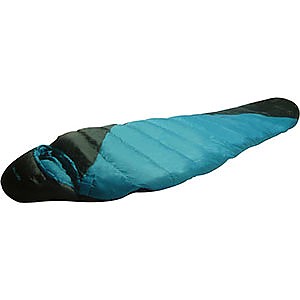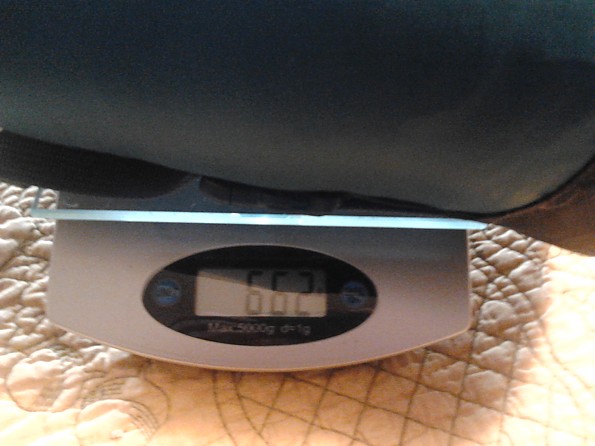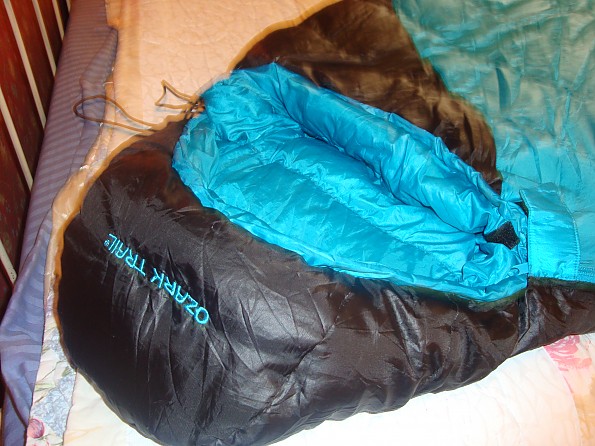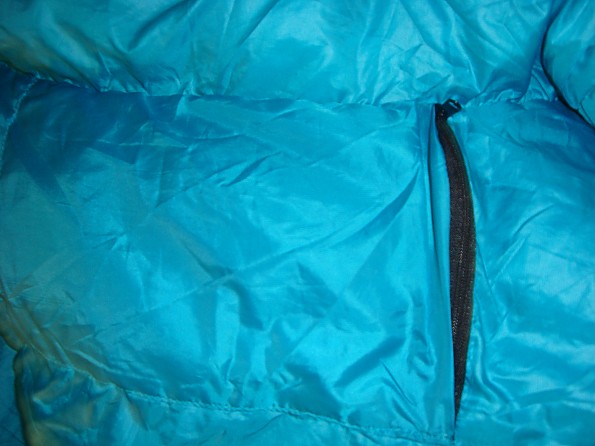Ozark Trail Cocoon 200

A shock to anyone familiar with Ozark Trail products...I think the company just might have (knowingly or unknowingly) manufactured the best entry-level 3-season sleeping-bag available!
Pros
- Cost
- Construction
- Design
- Social Justice?
Cons
- Uneven fill
- Color
- No fancy label
32-Degree Ozark Trail Cocoon 200 Down Sleeping-Bag
Introduction
There is a lot of truth to the old adage…you get what you pay for…though many times you do not get what you pay for…and only rarely do you ever get more than what you pay for. To my surprise (shock actually) the Ozark Trail Cocoon 200 down sleeping-bag I got from Walmart early last year gave me more than what I paid for…and in all truth…it is the best entry-level sleeping bag I have come across in over twenty years.
It is such a value in fact…that I have on more than one occasion found myself laughing (alone in the woods) at what a great overall value the bag is…and I promised myself in those moments that I would do a review to share my discovery.
As unimaginable as it is…the following is a highly favorable review of a wonderful piece of kit manufactured by a company that has a less than perfect reputation. Due to this reputation and what I see as the crucial niche I see this bag filling...I felt it necessary to provide a more robust review in the hopes of answering the questions that readers might have about the bag...but also to justify my claim that the Ozark Trail Cocoon 200 might be the best entry-level bag available.
Entry-Level
When it comes to the average person looking to get a new sleeping-bag for the few weekends/weeks they spend sleeping outdoors a year (in typically very mild conditions) with a few exceptions they basically have two options:
1) heavy and large synthetic discount sleeping-bag
2) expensive state of the art synthetic or down sleeping-bag or quilt.
Choice number one is basically useless for everyone but the folks who are walking no more than a few feet from car to tent…but choice number two is prohibitively expensive…even for the folks who do earn enough to afford it…it is highly unlikely that they will use the sleeping-bag or quilt enough to truly get $300-$600 worth of value out of the bag (which comes to nothing more than saving a few ounces of weight and cubic inches of space).
The Ozark Trail Cocoon 200 breaks away from this bifurcated (unjust?) market state…by providing a low-cost (what I am calling entry-level) sleeping-bag that is thoughtfully designed and overall well-constructed. Where the bag cuts cost the average user should be (I would argue) mostly unaffected…as most would gladly trade off a few ounces of weight…a few cubic inches of space…and a fancy label for a bag somewhere between 3-7 times cheaper!
Cash savings which can in turn be used to purchase better shoes…a better pack…and a better shelter…which will increase enjoyment in the outdoors infinitely more than a fluffy fancy-labeled sleeping bag by every step a person takes…ounce he or she carries…and drop of rain he or she is shielded from.
Description
The Ozark Trail Cocoon 200 comes in a nice compression sack…which is basically useless and subjects your sleeping-bag to undue compression…which can hinder the performance of the down to trap warm air around you (I usually turn these into ditty-bags). Fully compressed…the Ozark Trail Cocoon 200 measures 11 inches in length and 5.5 inches in diameter inside the compression sack. Bucking the industry norm for exaggerating how light their bag is…Ozark Trail list their bag at an astounding 104 grams over what my digital scales report...and that's with the compression sack.
Minus the compression sack the bag weighs a respectable 616 grams or just over 21.7 ounces. To put that into perspective…at <$80 the 32-Degree Ozark Trail Cocoon 200 weighs less than the $129 (plus S/H) 40-Degree Kelty Cosmic (the only comparable bag within $100). If that still is not perfectly clear…you get both a lighter and warmer rated bag for around $50 less with the Ozark Trail Cocoon 200 (see above for what to do with that savings to increase enjoyment infinitely more).
It can be difficult to get reliable measures of a sleeping bag by yourself…so I will use my body-measures as reference…I am 5-10 and have a 48 inch chest…the bag fits me with room to spare lengthwise and comfortably snug in the chest and torso area. If you are more than 6 feet tall…or have a larger chest or biceps than I do…the bag might be too small for you…but before I purchased the bag I crawled inside and rolled around in the aisle to the delight of the clerk before deciding to buy…which I strongly recommend everyone do anyways (the clerk only thought I was crazy for 2-3 minutes).
The Ozark Trail Cocoon 200 comes in one choice of color (so no dilemmas there!)…a bold half teal and half black design that I can only imagine is the result of a surplus on Teal color fabric. No worries though…I love getting the color-discount on Amazon…and would wear Day-Glo pink trekking pants like a badge of honor if it saved me $5.
My best guess is that the inside and outside of the bag are constructed with a 30 denier rip-stop polyester…what I am certain of is that the fabric used in the construction of the bag is comparable to that which is used in some of the very best and lightest sleeping-bags and quilts available…and the decision to use this lightweight fabric is one of the best aspects of the bag overall…because it not only lowers the overall weight of the bag significantly…it more importantly allows the down to expand more fully than it might with heavier fabrics.
The Ozark Trail Cocoon 200 comes with a large zipper that is available in both a left and right option. The large zippers are a bit of overkill in my opinion…but for folks who like to pull their way out of a difficult situation when it comes to zippers…the overly-robust zipper should prevent some unpleasant mishaps resulting from unwarranted zipper pulling.
Along the zipper a grosgrain zipper-stiffener and a pleasantly over-sized draft tube runs the entire length of the bag…features one comes to expect of high-end bags to be sure…but not something I would necessarily expect from an $80 sleeping-bag. I have never really had the problems with zippers that others complain about…but in the year of testing I have subjected this bag to I was always easily able to zip the bag open and closed using a single hand…and the draft tubes kept that cold zipper and drafts on the other side of my warm pocket of air.
The hood of the Ozark Trail Cocoon 200 uses some of the very best design features found in sleeping-bags made by such notables as Western Mountaineering. For example…the hood uses what is called a reverse differential construction which is a fancy way of saying that it uses over-sized cuts of fabric on the inside of the hood to allow the down to fill in around the head without the need to over-cinch the hood. The hood also includes a full-collar with shock-cord pulls to cinch it snugly around the head and neck preventing the loss of precious heat.
The criticisms I have of the hood are not that substantial…but I did find the hood somewhat over-filled...and I believe that the additional down could have been better served placed in the torso area where I found the distribution of down wanting. Beyond this…the cord-locks and shock-cord used are too large in size and diameter respectively.
By replacing these two things I am sure the weight of the bag would be dropped by another ounce or two (that’s how over-sized they are)…but again…this is a bag for the average person…who likely does not mind the additional size and weight of these items in exchange for the obscene durability they provide.
The torso of the Ozark Trail Cocoon 200 is probably the aspect of the bag I was most underwhelmed by…it does use internal baffling in the construction (which is labor intensive)…but as I mentioned previously the fill in the torso area of the bag is a little more sparse than it is in other areas of the bag (this could be a quality-control issue and not representative of the bags as a whole).
The fill is adequate for the average user who is never going to take the bag to the bottom of its temp-rating…but while using the bag in sub-freezing temps I found the insulation in the torso of the bag noticeably colder than other areas. This is easily compensated for by simply wearing warmer clothing on the torso to bed (which you have anyways because it is winter)…but I feel it would be a mistake not to mention the unequal distribution of insulation throughout the bag for those who would be put-off by it (though unequal distribution is not actually that uncommon and very much a common practice for bags designed for women).
The foot-box of the Ozark Trail Cocoon 200 is all quality…roomy and delightfully filled…you will not want for cold feet in this thing...though you should certainly wear socks inside your bag! The only difference between the foot box on the Ozark Trail Cocoon 200 and a top-quality bag is that some of your more quality bags will sometimes use a heavier fabric on the foot-box to prevent holes from abrasion and puncture…but this only adds undue weight in most cases...and not something I prefer.
Oh!...and for those who like features and other nonsense there is an inside pocket inside the torso of the sleeping-bag to help you misplace small items…so that you can discover them a year or more later after you have replaced them.
Conclusion
Just to be clear this is not the best sleeping-bag available…it is not a Feathered Friends or Western Mountaineering bag by any stretch of the imagination. While completely honest and upfront…my review of this bag is unapologetically colored by my enthusiasm for the niche I believe this bag fills…and to that end…I believe it fills that niche better than any other bag available.
Sadly…most folks are not able…or do not choose…to spend between 50-80 nights a year outdoors as I do…in fact…most spend less than 10 nights a year outdoors (if that)…so who in good conscience believes these folks should spend $300-$600 on a sleeping-bag they will only use <10 nights? Until more recently folks did not really have much of a choice…because the discount bags available were (with few exceptions) unholy things that were completely unusable for backpacking.
From the perspective of the average person…the Ozark Trail Cocoon 200 is a great bag…that is both well-designed and well-made for about the price of your average discount bag. Sure the filling is 10% feathers…and the down is most certainly at the bottom of the scale in terms of fill-power…but when all is said and done 3 inches of loft from fill that is 90/10 down and feather respectively is for the average person (also me) indistinguishable from 3 inches of loft from fill that is completely top-of-the-line 900 fill-power down. The compromise is not in insulation value...but primarily weight and compression.
Still...despite the use of lower quality down…the weight of the Ozark Trail Cocoon 200 is certainly on the light-side of the spectrum given its temp-rating...and the difference in compression is hardly a factor given that one should try to compress their bag as little as possible…as even the best down can take a while to fully expand and migrate when excessively compressed.
Testing
The testing for the Ozark Trail Cocoon 200 was initially done between the months of March and May 2013...paused for summer...and then resumed again between the months of September and December 2013. During these periods I used the bag on 8 trips for durations between 2-5 days…as well as two nights in a hammock at my home during the month of April 2013. The nighttime temperatures for these trips and overnights all ranged between low 50s and low 20s.
In addition…the bag was also subjected to three days and two nights of biblical proportion rainstorms during the month of October 2013.
Source: bought it new
Price Paid: $69.99
Don't even think this bag is available anymore.. Got the last two at our Wally World in Slidell, La. Used four nights at 11,000 ft. at Snowmass Mtn., Colo. Temps from low 40s up. No problems. Warm, comfy light. I'm 6 ft., 215 lbs., little snug but slept. If I felt tight, I'd unzip the bottom zipper by my ankles...unzip it about a foot and a half...allowed one leg to flex out. NICE!
Stuffed my little pillow in the hood section under my neck. Cozy. Packs very small. Big zips, big clips, small price. Wife loved hers, found it warm and cozy. $49 each at Wally's. Love them! And we got the left and right zippered. Haven't tried it yet, but they do zip together rather easily. Love these bags!
Pros
- Price
- Warmth
- Features...Features...FEATURES!
Cons
- Could use a lil more down, but not complaining.
My wife and I used these bags for four nights on our hike to Snowmass Lake on the Snowmass Creek Trail outside of...you guessed it...Snowmass, Colo. Wife had not really touched hers until she laid it out to sleep in. When she crawled in the first thing she mentioned, in about 30 seconds, was how warm and comfy it was.
What a relief. I did tons of research and reading reviews, years of studying sleeping bags getting ready for this trip. Certainly glad to hear she was warm and comfy in it!
I really liked how I could cinch the hood and collar down to keep more warmth in or open it up to cool off. I also liked the two zippers, so I could open up the foot box if too hot or stretch my legs apart. I'm a hot sleeper anyway.
Both my wife and I were VERY happy with these bags. If I could change anything...maybe make it just a tad wider for us big guys. Nonetheless, I was still comfy and warm, and that's what the bag is designed to do. The facts of its weight and price are huge added bonuses in my book.
Have I mentioned, I love this bag.
Source: bought it new
Price Paid: $49
Love the compactability and being lightweight, but not for temps below mid 40s.
Pros
- Lightweight
- Compact
Cons
- Too trim for movement
Trusted the claim that it would be warm enough for fall camping. NOT!!
We woke in our tent to low to mid 30s for four nights and we felt absolutely frozen every night, particularly our feet. Our torsos were warm enough by wearing ALL our clothes and pulling the hood all the way down over our faces allowing no cold air, but our feet were in danger of damage, even with two pairs of wool socks.
The bags were adequate last year when temps dropped to mid to high 40's.
Is there a way for me to add more down, especially to the feet area, without damaging the bag?
Source: bought it new
Great bag! Very durable if used for large dogs and light enough for them to carry!
Pros
- contruction
- weight
- pack size
I do a lot of winter backpacking and needed a bag for my big, but short haired, canine companion. I picked this up at Walmart one day and have had it for two years it has withstood 4 continuous months of winter backpacking the AT. This involved a big dog crawling in an out of it every night for a third of a year and never once tearing it with his claws. I imagine it would hold up for a while with only a person using it.
Source: bought it new
Price Paid: $80












